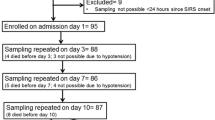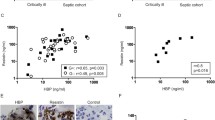Summary
The effect of immunglobulin (Ig) preparations on neutrophil phagocytic ability and oxidative burst in response toEscherichia coli stimulation was analyzed in 14 patients with gram-negative septicemia by anex vivo whole blood assay using flow cytometry. In patients, neutrophils exhibited a decreased capacity to phagocytizeE. coli and generate reactive oxygen products compared to healthy controls (median −68%, P<0.01). The addition of both 7S-Ig and 19S-Ig enriched preparationsin vitro resulted in a dose-dependent increase in neutrophil reactive oxygen production at concentrations of 10 g/l (median +153% and +211%, P<0.01, respectively) and 20 g/l (median +205% and +282%, P<0.01, respectively). A decreased neutrophil phagocytic ability was seen in patients with septicemia (median −58%) compared to healthy controls (P<0.01). Again, the addition of 7S and 19S-Igs enhanced the phagocytic ability in a dose-dependent manner (10 g/l: median +56 and +126%; 20 g/l: median +126% and +165%, P<0.01 for all). It can be concluded that both polyclonal Igs can increase depressed neutrophil reactive oxygen production and neutrophil phagocytosis in patients with gram-negative septicemia.
Similar content being viewed by others
References
Sibbald, W. J., Vincent, J. L.: Roundtable conference on clinical trials for the treatment of sepsis. Chest 107 (1995) 522–527.
Bryan, C. S., Reymolds, K. L., Brenner, E. R.: Analysis of 1186 episodes of gram-negative bacteremia in non-university hospitals: the effects of antimicrobial therapy. Rev. Infect. Dis. 4 (1983) 629–638.
Morrison, D. C., Ryan, J. L.: Endotoxins and disease mechanisms. Ann. Rev. Med. 38 (1987) 417–432.
Weiss, S. L.: Tissue destruction by neutrophils. N. Engl. J. Med. 320 (1989) 365–375.
Wenisch, C., Graninger, W.: Are extrinsic factors relevant for polymorphonuclear leukocyte dysregulation in patients with gram-negative septicemia? Clin. Diagn. Lab. Immunol. 2 (1994) 241–245.
The Intravenous Immunoglobulin Collaborative Study Group: Prophylactic intravenous administration of standard immune globulin as compared with core-lipopolysaccharide immune globulin in patients at high risk of post surgical infection. N. Engl. J. Med. 327 (1992) 234–240.
Schedel, I., Deickhausen, U., Neutwig, B., Höckenschmieder, M., Rauthmann, D., Balik Lioglu, S., Coldewey, R., Deicher, H.: Treatment of gram-negative septic shock with an immunoglobulin preparation: a prospective, randomized clinical trial. Crit. Care Med. 19 (1991) 1104–1113.
Cometta, A., Baumgartner, J. S., Glauser, M. P.: Polyclonal intravenous immune globulin for prevention and treatment in critically ill patients. Clin. Exp. Immunol. 97 (Suppl. 1) (1994) 69–72.
Wagner, D. R., Heinrich, D.: Influence of polyclonal immunoglobulins on the polymorphonuclear leukocyte response to lipopolysaccharide ofSalmonella enteritidis as measured with luminol enhanced chemiluminescence. Infect. Immun. 64 (1994) 4320–4324.
Sawjer, D. W., Donawitz, G. R., Mandell, G. L.: Polymorphonuclear neutrophils: an effective antimicrobial force. Rev. Infect. Dis. 7 (1989) 1533–1544.
Simms, H. H., Amico, R. D.: Polymorphonuclear leukocyte dysregulation during the systemic inflammatory response syndrome. Blood 83 (1994) 1398–1407.
Bassoe, C. F., Solberg, C. O.: Phagocytosis ofStaphylococcus aureus by human leukocytes: quantification by a flow cytometric and a microbiological method. Acta Path. Microbiol. Immunol. Scan. Sect. C 92 (1984) 43–50.
Rothe, G., Oser, A., Valet, G.: Dihydrorhodamine 123: a new cytometric indicator for respiratory burst activity in neutrophil granulocytes. Naturwissenschaften 75 (1988) 354–355.
Trinkle, L. S., Wellhausen, S. R., Eish, U. R.: A simultaneous flow cytometric measurement of neutrophil phagocytic and oxidative burst in whole blood. Diagn. Clin. Immunol. 5 (1987) 62–68.
Bassoe, C. F.: Flow cytometric studies on phagocytic function in bacterial infections. Acta Path. Microbiol. Immunol. Scand. Sect. C 92 (1984) 167–171.
Raybourne, R. B., Bunning, V. K.: Bacterium-host cell interactions at the cellular level: fluorescent labeling of bacteria and analysis of short-term bacterium-phagocyte interaction by flow cytometry. Infect. Immun. 62 (1994) 665–672.
Cantineaux, B., Hariga, C., Courtay, P., Hupin, J., Fondu, P.:Staphylococcus aureus phagocytosis: a new cytofluorometric method using FITC and paraformaldehyde. J. Immunol. Meth. 121 (1989) 203–208.
Bone, R. C.: Let's agree on terminology: definition of sepsis. Crit. Care Med. 19 (1991) 973–976.
Pilz, G., Kreuzer, E., Kääb, S., Appel, R., Werdan, K.: Early sepsis treatment with immunoglobulins after cardiac surgery in score-identified high-risk patients. Chest 105 (1994) 76–82 (errata in 105 [1994]).
Cohen, S., Porter, R. R.: Structure and biological activity of immunoglobulins. Adv. Immunol. 4 (1964) 287–291.
Ziegler, E. J., Fisher, C. J., Sprung, C. L., Straube, R. C., Sadoff, J. C., Foulke, G. E., Wortel, C. H., Fink, M. P., Dellinger, R. P., Teng, N. N.: Treatment of gram-negative bacteremia and septic shock with HA1A human monoclonal antibody against endotoxin. N. Engl. J. Med. 324 (1991) 429–436.
Carbett, N. S., Muucro, C. S., Cole, P. J.: Opsonic activity of a new intravenous immunoglobulin preparation: pentaglobin compared with sandoglobin. Clin. Exp. Immunol. 76 (1989) 8–12.
Tympner, K. D., Klose, P. K., Janka, G., Liegel, D.: Einfluß intravenös verträglicher Immunglobuline auf die Phagozytose-Leistung der Granulozytenin vitro. Münch. Med. Wochenschr. 8 (1978) 251–252.
Fleit, H. B., Wright, S. D., Unkeless, J. C.: Human neutrophil Fc receptor distribution and structure. Proc. Natl. Acad. Sci. USA 79 (1982) 3275–3279.
Kurlander, R. F., Batker, J.: The binding of human immunoglobulin G1 monomer and small, cavalently cross-linked polymers of immunoglobulin G1 to human peripheral blood monocytes and polymorphonuclear leukocytes. J. Clin. Invest. 69 (1982) 1–8.
Unkeless, J. C.: Function and heterogenity of human Fc receptors for immunoglobulin G. J. Clin. Invest. 83 (1989) 355–361.
Pilz, G., Appel, R., Kreuzer, E., Werdan, K.: Comparison of early IgM-enriched immunoglobulin vs polyvalent IgG administration in score-identified postcardiac surgical patients at high risk for sepsis. Chest 11 (1997) 419–426.
Collins, M. S., Hector, R. F., Roby, R. E., Edwards, A. A., Ladehoff, D. K., Dorsey, J. H.: Prevention of gram-negative and gram-positive infections using three intravenous immunoglobulins and therapy of experimental polymicrobial burn infection using intravenousPseudomonas immunoglobulin G and ciprofloxacin in an animal model. Infection 15 (1987) 60–68.
Author information
Authors and Affiliations
Rights and permissions
About this article
Cite this article
Wenisch, C., Parschalk, B., Patruta, S. et al. Effect of polyclonal immunoglobulins on neutrophil phagocytic capacity and reactive oxygen production in patients with gram-negative septicemia. Infection 27, 183–186 (1999). https://doi.org/10.1007/BF02561525
Received:
Accepted:
Issue Date:
DOI: https://doi.org/10.1007/BF02561525




